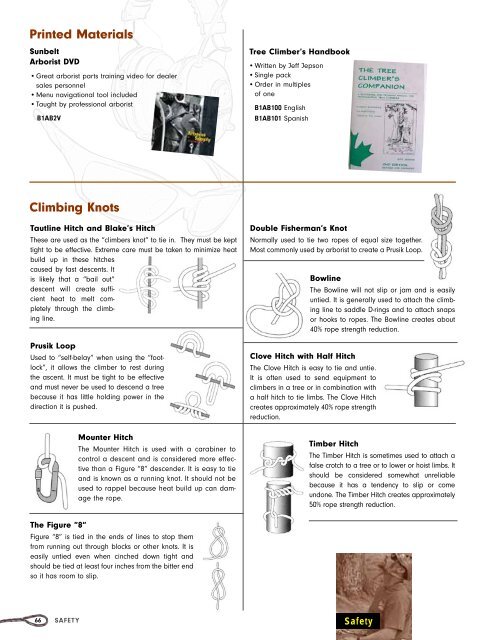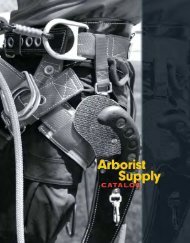Rope - True Radius Marketing
Rope - True Radius Marketing
Rope - True Radius Marketing
You also want an ePaper? Increase the reach of your titles
YUMPU automatically turns print PDFs into web optimized ePapers that Google loves.
Printed Materials<br />
Sunbelt<br />
Arborist DVD<br />
• Great arborist parts training video for dealer<br />
sales personnel<br />
• Menu navigational tool included<br />
• Taught by professional arborist<br />
B1AB2V<br />
Tree Climber’s Handbook<br />
• Written by Jeff Jepson<br />
• Single pack<br />
• Order in multiples<br />
of one<br />
B1AB100 English<br />
B1AB101 Spanish<br />
Climbing Knots<br />
Tautline Hitch and Blake’s Hitch<br />
These are used as the “climbers knot” to tie in. They must be kept<br />
tight to be effective. Extreme care must be taken to minimize heat<br />
build up in these hitches<br />
caused by fast descents. It<br />
is likely that a “bail out”<br />
descent will create sufficient<br />
heat to melt completely<br />
through the climbing<br />
line.<br />
Prusik Loop<br />
Used to “self-belay” when using the “footlock”,<br />
it allows the climber to rest during<br />
the ascent. It must be tight to be effective<br />
and must never be used to descend a tree<br />
because it has little holding power in the<br />
direction it is pushed.<br />
Mounter Hitch<br />
The Mounter Hitch is used with a carabiner to<br />
control a descent and is considered more effective<br />
than a Figure “8” descender. It is easy to tie<br />
and is known as a running knot. It should not be<br />
used to rappel because heat build up can damage<br />
the rope.<br />
Double Fisherman’s Knot<br />
Normally used to tie two ropes of equal size together.<br />
Most commonly used by arborist to create a Prusik Loop.<br />
Bowline<br />
The Bowline will not slip or jam and is easily<br />
untied. It is generally used to attach the climbing<br />
line to saddle D-rings and to attach snaps<br />
or hooks to ropes. The Bowline creates about<br />
40% rope strength reduction.<br />
Clove Hitch with Half Hitch<br />
The Clove Hitch is easy to tie and untie.<br />
It is often used to send equipment to<br />
climbers in a tree or in combination with<br />
a half hitch to tie limbs. The Clove Hitch<br />
creates approximately 40% rope strength<br />
reduction.<br />
Timber Hitch<br />
The Timber Hitch is sometimes used to attach a<br />
false crotch to a tree or to lower or hoist limbs. It<br />
should be considered somewhat unreliable<br />
because it has a tendency to slip or come<br />
undone. The Timber Hitch creates approximately<br />
50% rope strength reduction.<br />
The Figure ”8“<br />
Figure “8” is tied in the ends of lines to stop them<br />
from running out through blocks or other knots. It is<br />
easily untied even when cinched down tight and<br />
should be tied at least four inches from the bitter end<br />
so it has room to slip.<br />
66<br />
SAFETY<br />
Safety



